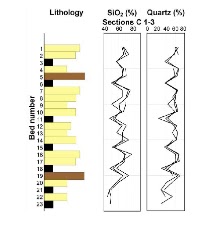Paleosols represent
atmosphere-influenced sediment alteration during periods of landscape
stability. To better understand paleosols and paleoclimate of the late
Paleozoic ice age, two papers (Rosenau et al. and Rosenau et al.) characterize the macro-morphology, micro-morphology,
mineralogy, isotopes, and stratigraphic and lateral distribution of paleosols
in Pennsylvanian (Atokan-Virgilian) mixed marine and terrestrial coal-bearing
strata (“cyclothems”) in the Illinois basin. The data illustrate intra- and inter-cyclothem
variability in paleosol morphology, mineralogy, and isotopes interpreted to
reflect marked paleohydrologic variability driven by a combination of autogenic
basin-scale controls (such as groundwater fluctuations) and allogenic regional-
to global-scale controls (such as glacioeustasy and climate). These results
refine understanding of the complex, polygenetic origin of these paleosols and
the paleoclimate changes during deposition.
Unraveling stratigraphic
variability represents a complex challenge in heterogeneous, fossil-poor
successions. In this study of a late Miocene submarine slope–channel system in
the Tabernas Basin of southern Spain, Aehnelt et al. apply X-ray fluorescence, X-ray diffraction, and SEM analyses,
supplemented by light microscopy, to assess the utility of geochemical
correlation techniques for correlation. The observations suggest that sandstone
beds are geochemically homogenous (geochemical stratigraphy is comparable to
lithostratigraphy), but in some cases, geochemical evaluation using particular enrichments,
depletions, or major trends allows even more detailed correlation than simple
physical correlation. The results are interpreted to suggest that geochemical
stratigraphic correlations are valid over a range of scales (m to 100s of m),
but that geochemical correlations need to be applied with care if utilizing a
limited range of elements.
Globally
warm temperatures and elevated atmospheric CO2 in the Paleocene make
this epoch of particular interest for understanding greenhouse worlds; yet, terrestrial
records from this interval are rare, particularly in North America. In this study, Torres and Gaines examine morphology, clay mineralogy, and bulk
geochemistry
of paleosols from two members in the late Paleocene Goler Formation of Southern
California to investigate paleoclimatic change during deposition. The results reveal a shift in pedogenic
processes concomitant with changes in provenance and sedimentation rate. These data are interpreted to suggest that paleotopographic
change, driven by regional tectonic activity, was an important control on local
climate and pedogenic processes.
Alluvial
deposits have provided valuable insights into hydroclimatic variability and
paleoenvironments, yet, in dryland settings, the roles of allogenic and
autogenic processes are poorly constrained. Tooth et al. investigate the controls on
the genesis, sedimentary architecture and preservation potential of the
alluvial succession along the modern incising Modder River, located in the
tectonically stable South African interior far beyond the range of sea level
influence. The results show that whereas
allogenic factors may be the primary driver of river activity in inland
valleys, resistant rock barriers can exert additional complicating influences—stable barriers control the depth of cutting during climatically-driven
incisional phases, but once partial or complete barrier breaching occurs, deep
channel incision into bedrock will take place in reaches upstream, thus forming
prominent valley-base erosion surfaces and possibly promoting the formation of
incised gully networks. These findings are interpreted to provide insights that
can be applied to improved interpretation of comparable dry, inland alluvial
valleys preserved in the geological record.
Recent
studies of paleosols have provided important insights into landscape processes
and climate; yet, due to their landscape position, they may not be preserved. In
this paper, Gastaldo et al. describe
mudclast aggregates in anabranching deposits of the Triassic Katberg Formation
of South Africa. Results reveal that the aggregates are heterogenous coarse
silt to fine sand and are not found as matrix or within in situ paleosols; instead, they are associated with reworked
carbonate nodules and mudchip rip-up clasts. These attributes are used to
interpret the former presence of PaleoVertisols across the Early Triassic Karoo
landscape. These data and recognition of mud aggregates is interpreted to
reinforce the idea that mudclast aggregates are characteristic of closed
depositional systems, including continental-interior basins.




